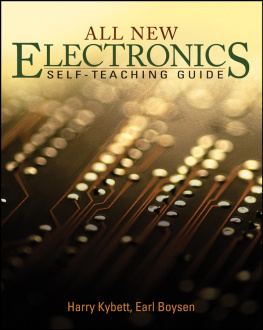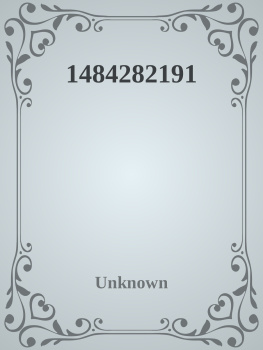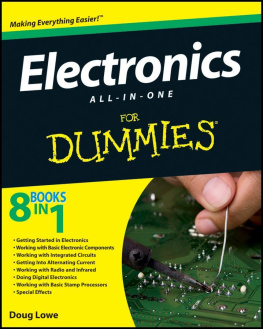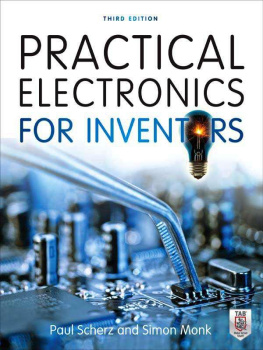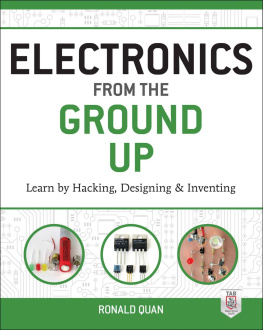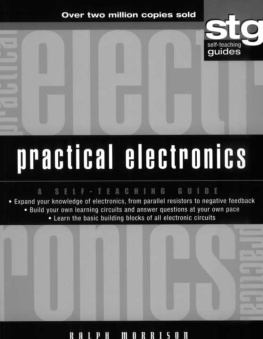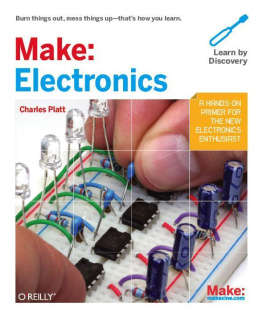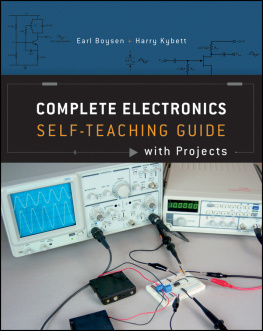
All New Electronics Self-Teaching Guide, Third Edition Published by Wiley Publishing, Inc. 10475 Crosspoint Boulevard Indianapolis, IN 46256 www.wiley.com Copyright 2008 Wiley Publishing, Inc., Indianapolis, Indiana Published simultaneously in Canada ISBN: 978-0-470-28961-7 No part of this publication may be reproduced, stored in a retrieval system or transmitted in any form or by any means, electronic, mechanical, photocopying, recording, scanning or otherwise, except as permitted under Sections 107 or 108 of the 1976 United StatesCopyright Act, without either the prior written permission of the Publisher, or authorization through payment of the appropriate per-copy fee to the Copyright Clearance Center, 222 Rosewood Drive, Danvers, MA 01923, (978) 750-8400, fax (978) 646-8600. Requests to the Publisher for permission should be addressed to the Legal Department, Wiley Publishing, Inc., 10475 Crosspoint Blvd., Indianapolis, IN 46256, (317) 572-3447, fax (317) 572-4355, or online at http://www.wiley.com/go/permissions. Limit of Liability/Disclaimer of Warranty: The publisher and the author make no representations or warranties with respect to the accuracy or completeness of the contents of this work and specifically disclaim all warranties, including without limitation warranties of fitness for a particular purpose. No warranty may be created or extended by sales or promotional materials. The advice and strategies contained herein may not be suitable for every situation.
This work is sold with the understanding that the publisher is not engaged in rendering legal, accounting, or other professional services. If professional assistance is required, the services of a competent professional person should be sought. Neither the publisher nor the author shall be liable for damages arising herefrom. The fact that an organization or Website is referred to in this work as a citation and/or a potential source of further information does not mean that the author or the publisher endorses the information the organization or Website may provide or recommendations it may make. Further, readers should be aware that Internet Websites listed in this work may have changed or disappeared between when this work was written and when it is read. at (800) 762-2974, outside the U.S. at (317) 572-3993 or fax (317) 572-4002. at (317) 572-3993 or fax (317) 572-4002.
Library of Congress Cataloging-in-Publication Data is available from the publisher. Trademarks: Wiley, theWiley logo, and are related trade dress are trademarks or registered trademarks of John Wiley & Sons, Inc. and/or its affiliates in the United States and other countries, and may not be used without written permission. All other trademarks are the property of their respective owners. Wiley Publishing, Inc., is not associated with any product or vendor mentioned in this book. Wiley also publishes its books in a variety of electronic formats.
Some content that appears in print may not be available in electronic books. To my wonderful wife Nancy. Thanks for wandering through life side by side with me. About the Author Earl Boysen is an engineer who, after 20 years working in the computer chip industry, decided to slow down and move to a quiet town in the state of Washington. Boysen is the co-author of three other books: Electronics for Dummies (Indianapolis: Wiley, 2005), Electronics Projects for Dummies (Indianapolis: Wiley, 2006), and Nanotechnology for Dummies (Indianapolis: Wiley, 2005). He lives with his wife, Nancy, in a house they built together, and finds himself busy as ever writing books and running two technology-focused Web sites.
His site, www.BuildingGadgets.com, focuses on electronics circuits and concepts. The other site, www.understandingnano.com, provides clear explanations of nanotechnology topics. Boysen holds a masters degree in Engineering Physics from the University of Virginia. Credits Executive Editor Carol Long Development Editor Kevin Shafer Technical Editor Rex Miller Production Editor Eric Charbonneau Copy Editor Mildred Sanchez Editorial Manager Mary Beth Wakefield Production Manager Tim Tate Vice President and Executive Group Publisher Richard Swadley Vice President and Executive Publisher Joseph B. Wikert Project Coordinator, Cover Lynsey Stanford Proofreader Sossity Smith Indexer Johnna VanHoose Dinse Acknowledgments I want to first thank Harry Kybett for authoring the original version of this book many years ago. It was an honor to update such a classic book in the electronics field.
Thanks also to Carol Long for bringing me on board with the project, and Kevin Shafer for his able project management of the book. My appreciation to Rex Miller for his excellent technical editing, and to Mildred Sanchez for handling all the mechanics of spelling and grammar in a thorough copy edit. Thanks to the people at Wiley, specifically Liz Britten for coordinating the creation of all the diagrams required and Eric Charbonneau for keeping the whole thing on schedule. Finally, thanks to my wife, Nancy Muir, for her advice and support throughout the writing of this book. Introduction The rapid growth of modern electronics is truly a phenomenon. All of the things you see in the marketplace today that utilize electronics either did not exist before 1960, or were crude by today's standards.
Some of the many examples of modern electronics in the home include the small (but powerful) pocket calculator, the personal computer, the portable MP3 player, the DVD player, and digital cameras. Many industries have been founded, and older industries have been revamped, because of the availability and application of modern electronics in manufacturing processes, as well as in electronics products themselves. Modern electronics is based on the transistor and its offspringthe integrated circuit (IC) and the microprocessor. These have short-circuited much of traditional electronic theory, revolutionized its practice, and set the whole field off on several new paths of discovery. This book is a first step to help you begin your journey down those paths. What This Book Teaches The traditional way of teaching electronics is often confusing.
Too many students are left feeling that the real core of electronics is mysterious and arcane, akin to black magic. This just is not so. In fact, while many areas of our lives have become almost unbelievably complex, the study and practice of electronics in industry and as a hobby has surprisingly been made much simpler. All New Electronics Self-Teaching Guide, Third Edition , takes advantage of this simplicity and covers only those areas you actually need in modern electronics. This book is for anyone who has a basic understanding of electronics concepts, but who wants to understand the operation of components found in the most common discrete circuits. The chapters in this book focus on circuits that are the building blocks for many common electronics devices, and on the very few important principles you need in working with electronics.
The arrangement and approach of this book is completely different from any other book on electronics in that it uses a question-and-answer approach to lead you into simple, but pertinent, experiments. This book steps you through calculations for every example in an easy-to-understand fashion, and you do not need to have a mathematical background beyond first-year algebra to follow along. In addition, this book omits the usual chapters on semiconductor physics, because you don't need these in the early stages of working with electronics. Electronics is a very easy technology, which anyone can understand with very little effort. This book focuses on how to apply the few basic principles that are the basis of modern electronic practice. Understanding the circuits composed of discrete components and the applicable calculations discussed in this book is useful not only in building and designing circuits, but it also helps you to work with ICs.

